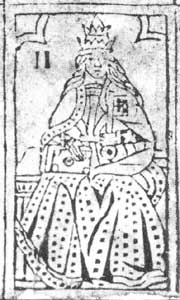Minchiate
The earliest reference to tarot cards, then known as trionfi, is dated to 1440 when a notary in Florence recorded the transfer of two decks to Sigismondo Pandolfo Malatesta.
The earliest reference to minchiate is found in a 1466 letter by Luigi Pulci to Lorenzo de' Medici.
First, in 97-card minchiate the sequence for some of the lower trumps goes from lowest to highest: Fortitude, Justice, Wheel, and Chariot.
[4] The song also ranks the other trumps as Fortitude, Justice, Chariot, and Wheel, which suggests it is a transitional stage from the Rosenwald sheets to the 97-card deck's order.
The rules used in these regions are lost, except for cryptic references that they were quite different from the Florentine game.
All surviving rules are derived from the type played in the Grand Duchy of Tuscany and the Papal States.
The game is described in detail by Romain Merlin in Origine des cartes à jouer, published in Paris in 1869.
In the minchiate deck, in the suits of cups and coins, the "knaves" or "pages" (Italian fanti) have been replaced by "maids" (fantine).
The knights, mounted figures in the tarot of Marseilles and similar designs, are centaurs or sphinxes in many minchiate decks.
The Republic of Lucca produced their own version of Minchiate decks which were very similar to the ones used in nearby Florence but with several graphical differences.
[7] Kings are seated under arches, knights are humans riding horses, all knaves are male, and the Fool is playing with a dog.
[4][25] The Empress, Emperor, and Pope became the new II, III, and IIII respectively, the latter now wearing a secular crown as opposed to a papal tiara.
Justice, Fortitude, and Temperance were three classical "cardinal virtues" depicted in the more familiar tarot trumps.
The minchiate completes the series by adding all the zodiac signs, in random order, and the four classical elements.
While 98-card decks were mentioned as being played in Sicily during the early 18th century, only a few examples from Genoa survive.
French engraver François de Poilly (1623–93) produced a French-suited Minchiate deck in the late 1650s after his return from Italy.
Each of the plain suits represent a different continent; spades for Africa, hearts for Europe, clubs for the Americas, and diamonds for Asia.
98 cards with 42 trumps order: He or another member of the family also reused the engravings to create a 78-card tarot set.
Mysterious French-suited decks produced by Piatnik of Vienna around 1930 also featured forty trumps.
Like the 54-card Industrie und Glück pattern, the plain suits consists of only 32 cards while the 40 trumps feature rustic genre scenes.
As in most tarot games, the pip cards in cups and coins are in reverse order and play is counter-clockwise.
The highest five trumps (Star, Moon, Sun, World, Trumpets) were called arie ("airs") and have a special high scoring value in the game.
Trumps 1, 3, 13, 20, 28, and 30-38 are considered valuable cards to capture or protect because they are required to form some versicole or to deny the opposition the same.
The minchiate deck was also used to play two games that don't use normal tarot rules, Al Palio and A sei tocchi.
His opponent leads the first trick but instead of letting the dealer play, she declares any meld she has and scores.
In Charles Godfrey Leland's 1890 book Aradia, or the Gospel of the Witches, an incantation is given that mentions the use of "40 cards", which are renamed in the spell as 40 gods who are being invoked to compel the goddess Laverna to do the caster's bidding.
[35] He has also pointed out that Leland's book Etruscan-Roman Remains in Popular Tradition (1892) contains a spell that is cast with tarocco cards,[36][37] to invoke Janus.



